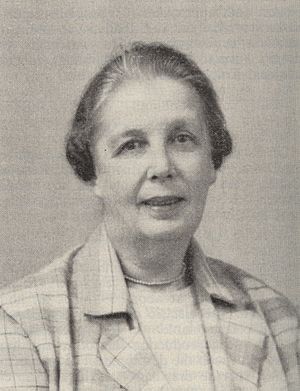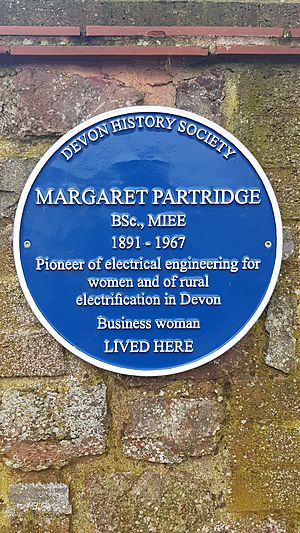Margaret Partridge facts for kids
Quick facts for kids
Margaret Partridge
|
|
|---|---|

Margaret Partridge, from The Woman Engineer
|
|
| Born |
Margaret Mary Partridge
8 April 1891 Nymet Rowland, Devon, England
|
| Died | 27 October 1967 |
| Nationality | British |
| Education | Bedford College, London |
| Occupation | Electrical engineer, businesswoman |
| Known for | Rural electricity installations, engineering apprenticeships |
Margaret Mary Partridge (born April 8, 1891 – died October 27, 1967) was a very important electrical engineer. She was also a businesswoman who started her own company. Margaret was a founding member of two important groups: the Women's Engineering Society (WES) and the Electrical Association for Women (EAW).
Her company worked with the Women's Engineering Society to find and train young women as engineers. One famous apprentice was Beatrice Shilling. Margaret also helped change a rule about women working at night. This happened after Beatrice was found working alone in a power station at night. This was against the rules at the time.
Contents
Early Life and Education
Margaret Partridge was born in Nymet Rowland, Devon, England, on April 8, 1891. Her father, John Leonard James Partridge, owned land. She had two brothers.
Margaret went to Bedford High School. She won a scholarship to study math at Bedford College, London in 1911. She earned her degree in 1914. After college, Margaret first tried teaching. But she soon found her true passion: engineering. She started working for an engineering expert in London.
Becoming an Engineer
'Today a man met me in the road and threatened to cut down some wires because he didn't like the look of them.'
In 1917, Margaret joined an engineering company called Arthur Lyon & Wrench. This company made searchlights. During World War I, many women got jobs in industries that were usually for men. Margaret took advantage of this. She trained to be an engineering apprentice. She quickly became a supervisor in the testing department.
After the war, Margaret decided to move back home to Devon. She started her own electrical business called M. Partridge & Co., Domestic Engineers. She advertised in The Woman Engineer, a magazine for women engineers. Her slogan was "Women for Women's Work."
Her company grew quickly. She started getting contracts to bring electricity to small towns and villages. Dr. John Purves, another electrical engineer, helped her a lot. He gave her practical advice and financial tips. Dr. Purves encouraged Margaret to set up companies to bring electricity to places like Cheriton Fitzpaine, Thorverton, and Bampton. For the first time, people in these areas had electricity in their homes! Most people were very happy. But Margaret also had to deal with some complaints about wires going across people's land.
Helping Women in Engineering
Margaret was a delegate at the first meeting to create the Electrical Association for Women (EAW). This meeting happened on November 12, 1924. Many important people from the electrical and engineering world were there. Also, many influential women's groups attended.
At the meeting, Mrs. Mabel Lucy Matthews suggested an organization. This group would help women by making electricity more available in homes. This would make housework easier. After a lively discussion, Margaret proposed a resolution. Everyone agreed to form a "Women's Electrical Association." The name was soon changed to the Electrical Association for Women. This was to avoid confusion with another group.
Margaret gave a speech at a big conference in 1925. It was called the International Conference of Women in Science, Industry and Commerce. She spoke about "Producing and Distributing Electricity." She shared the stage with other amazing engineers and scientists.
Margaret wanted to help young women who were interested in engineering. She offered apprenticeships especially for girls leaving school. She asked Caroline Haslett, another famous engineer, for recommendations. Margaret hired Beatrice Shilling, who was an immediate success. Margaret and her business partner, Margaret Rowbotham, encouraged Beatrice to study at Manchester University. Beatrice later became a pioneering engineer in aviation.
Beatrice Shilling was once found working alone at night in a power station. This was against a rule from the ILO. This rule said women were not allowed to do industrial work at night. With help from the Women's Engineering Society, this case led to a change in the rule in 1934. The new rule allowed women in supervisory roles to work at night.
During World War II, Margaret worked for the Ministry of Labour. She was a technical officer for the South West region. She advised factories on how to employ women in making wartime supplies.
Retirement and Later Work
After she retired, Margaret continued to live in Devon with Margaret Rowbotham. She encouraged the women in her local Women's Institute to get electricity for their village hall.
In 1962, Margaret and Margaret wrote a letter to their fellow women engineers. They shared "grandmotherly advice" about the joys of retirement. They listed many activities they were doing. These included designing a sports pavilion and helping turn a large house into a boys' school. Margaret also served on her local Parish Council.
Margaret Partridge passed away at her home in Willand, Devon, on October 27, 1967. Both Margarets are buried in the Willand churchyard.
Work for the Women's Engineering Society
Margaret Partridge joined the Women's Engineering Society (WES) in 1920. She became the Vice-President of WES in 1942. Then, in 1943, she became the President. She took over from Gertrude Entwistle. Dr. Winifred Hackett became President after Margaret in 1946.
Remembering Margaret Partridge
A special blue plaque was put up at Margaret Partridge's former home in Willand, Devon, in March 2019. This plaque was placed by the Devon History Society to remember her important contributions.


